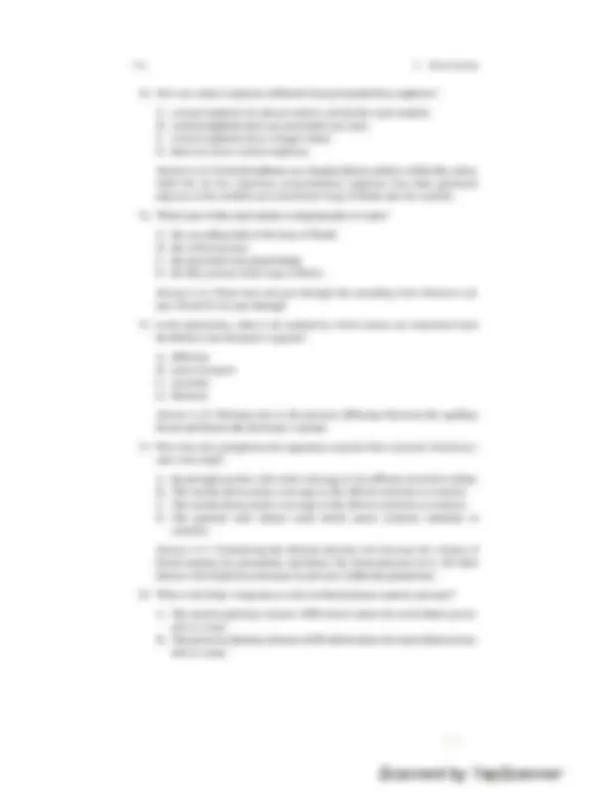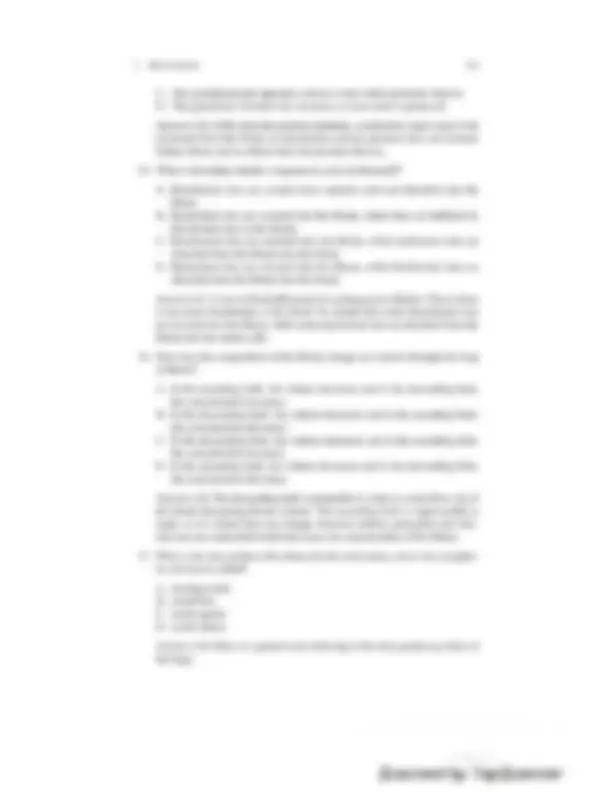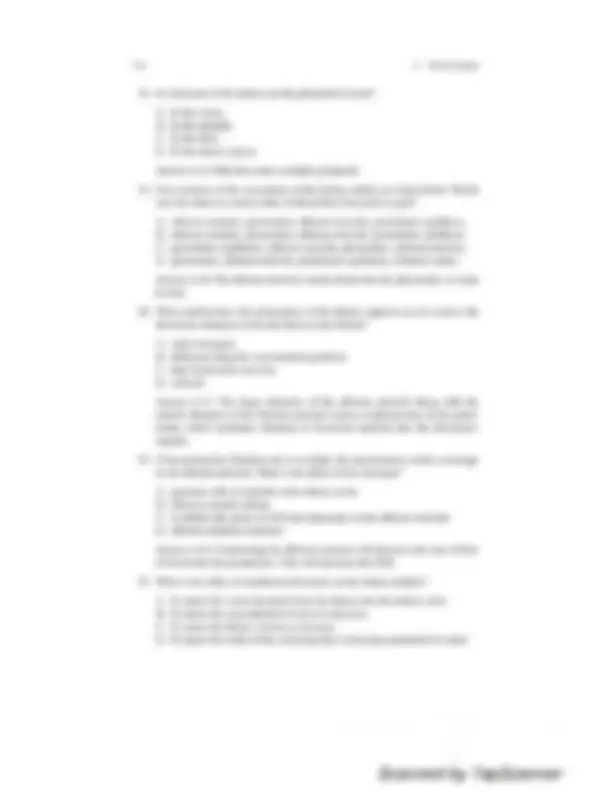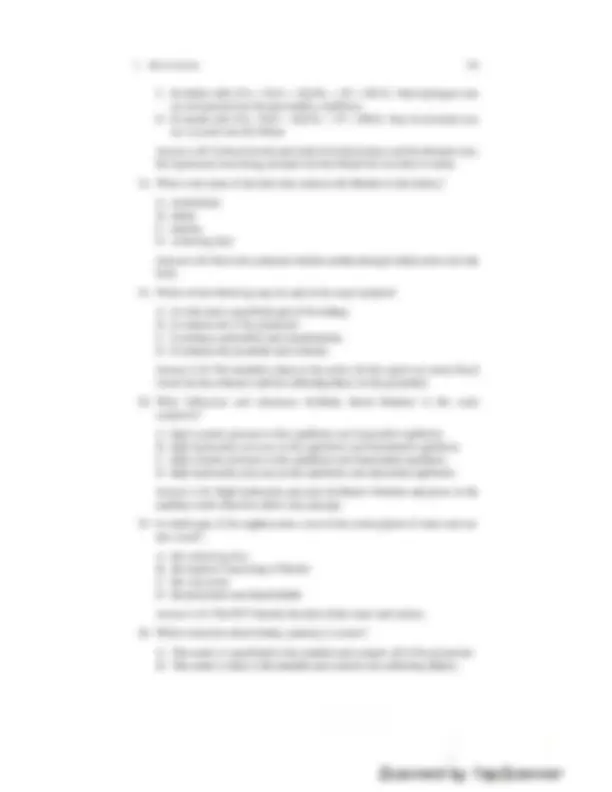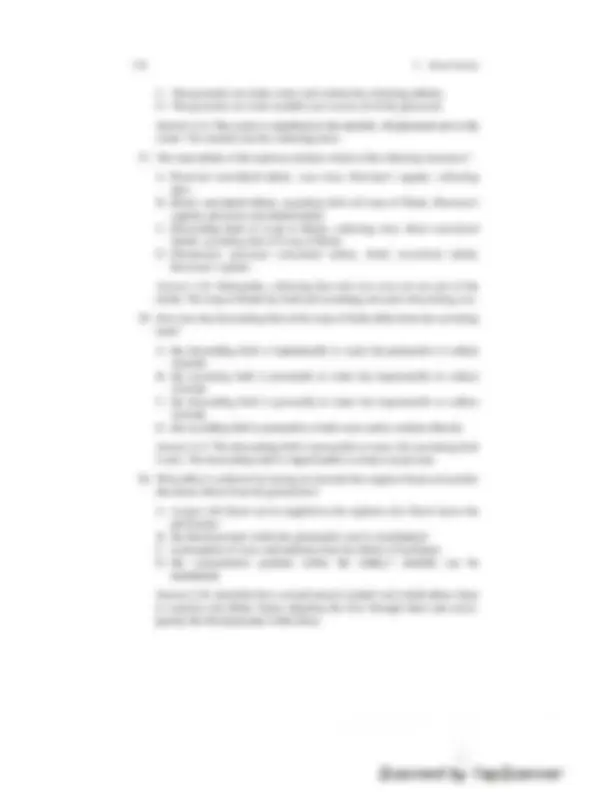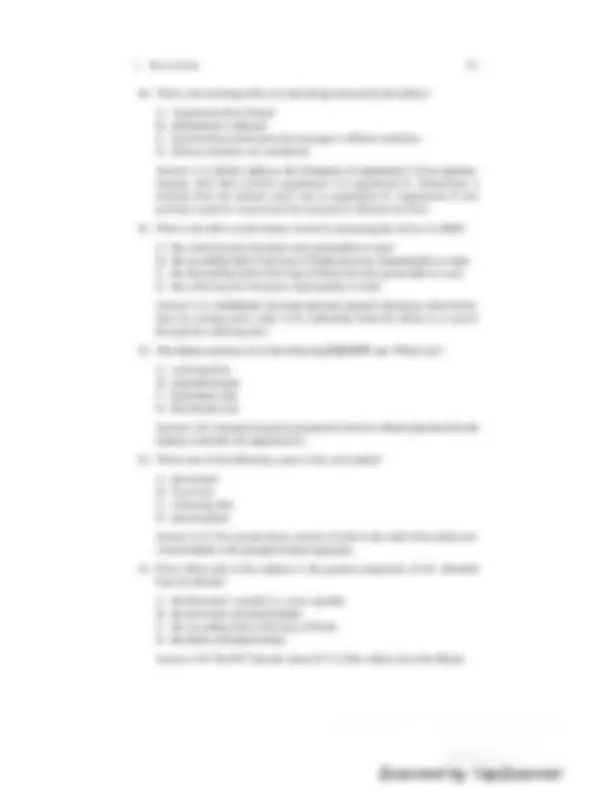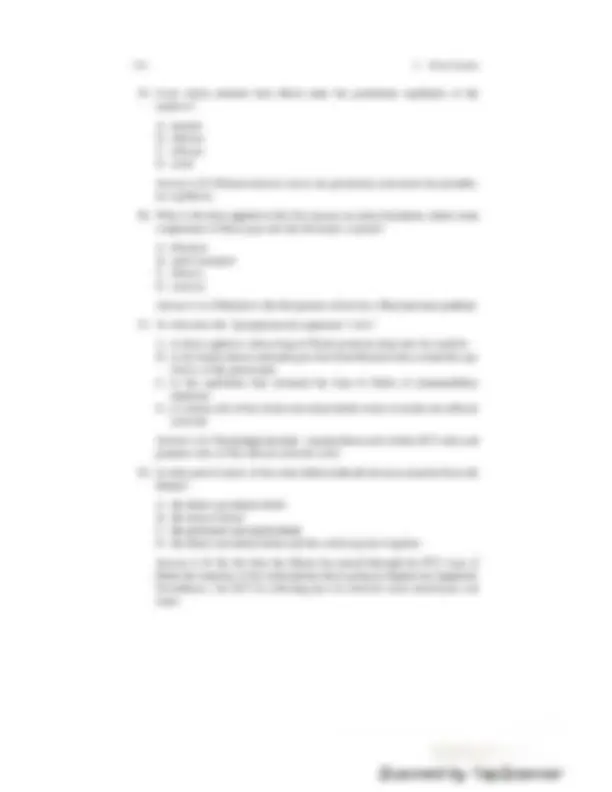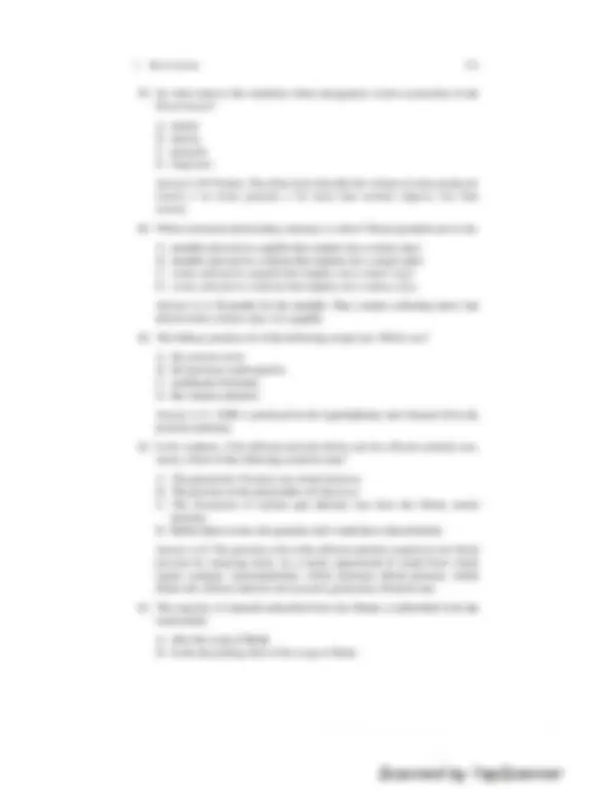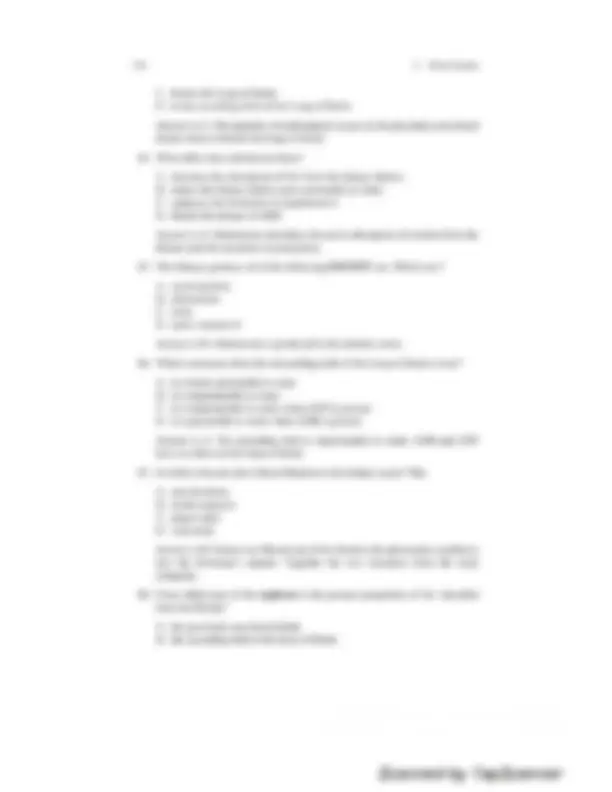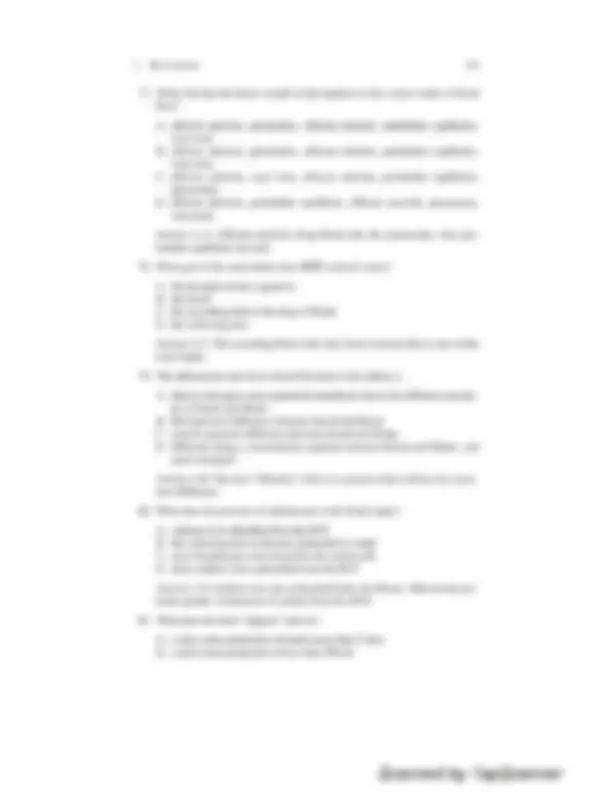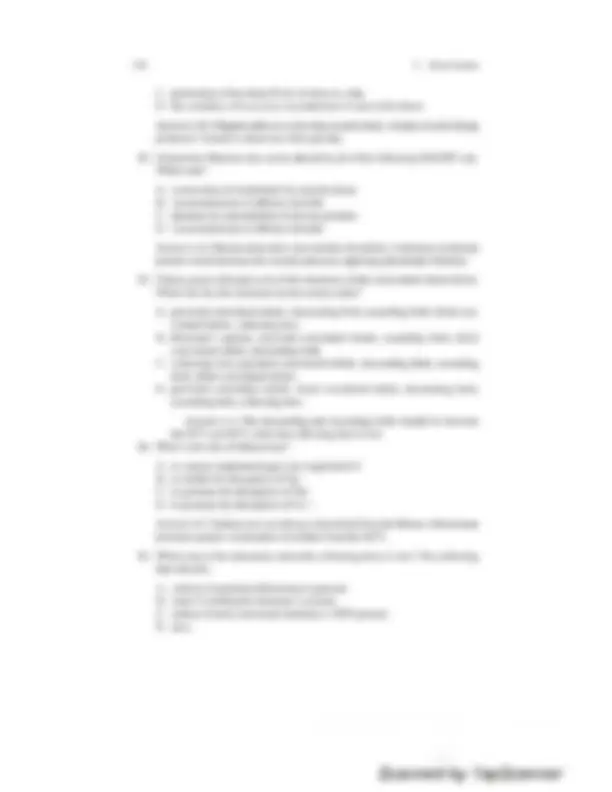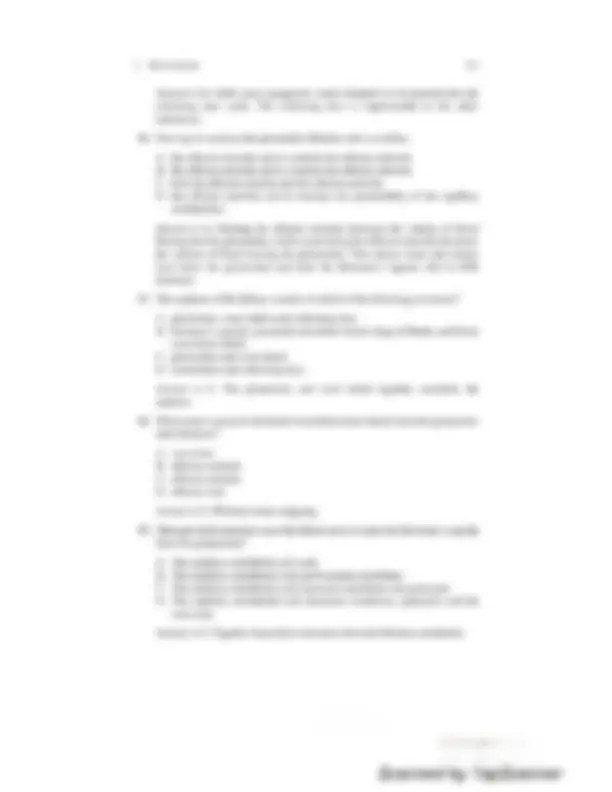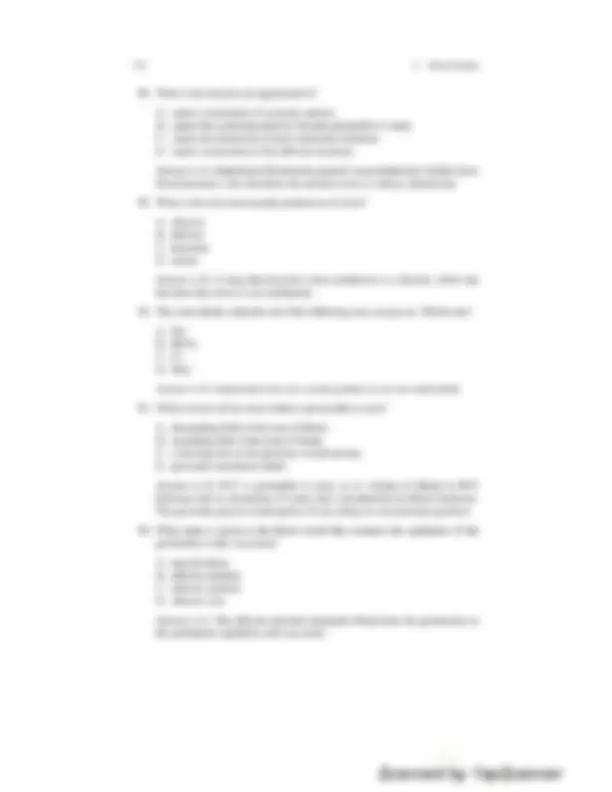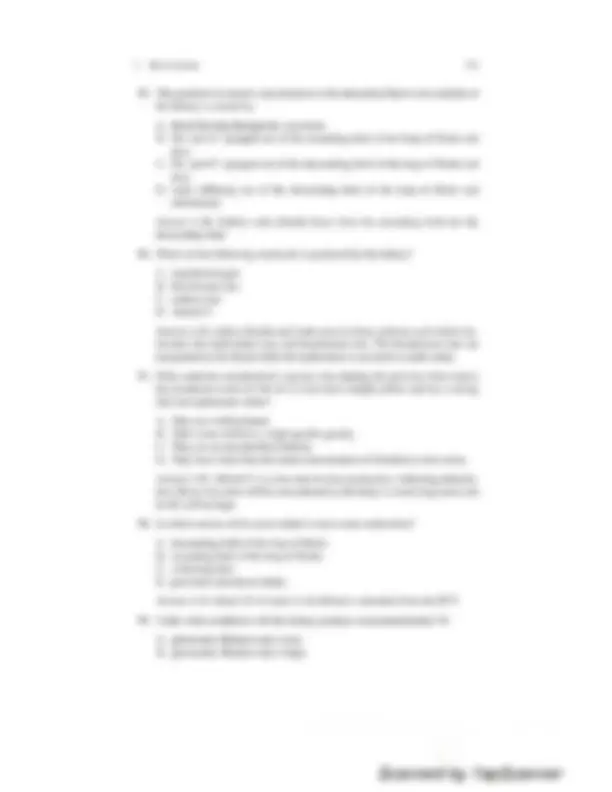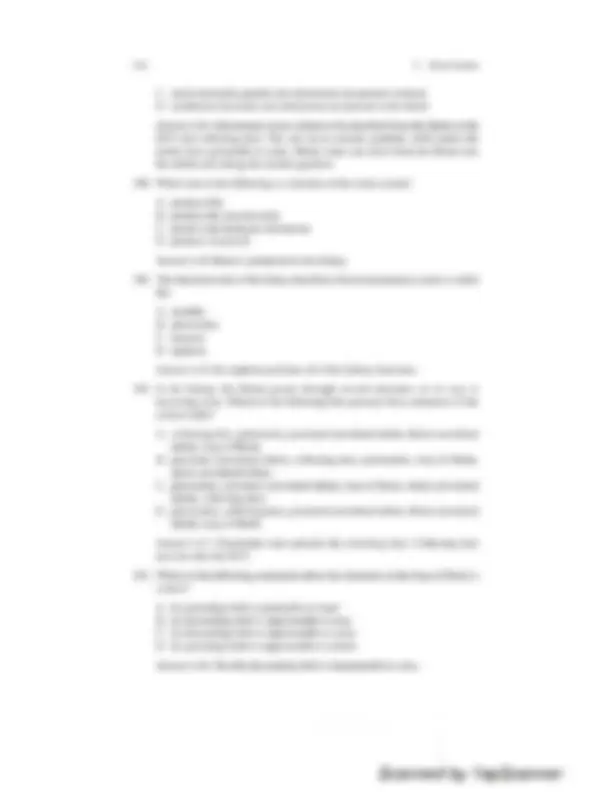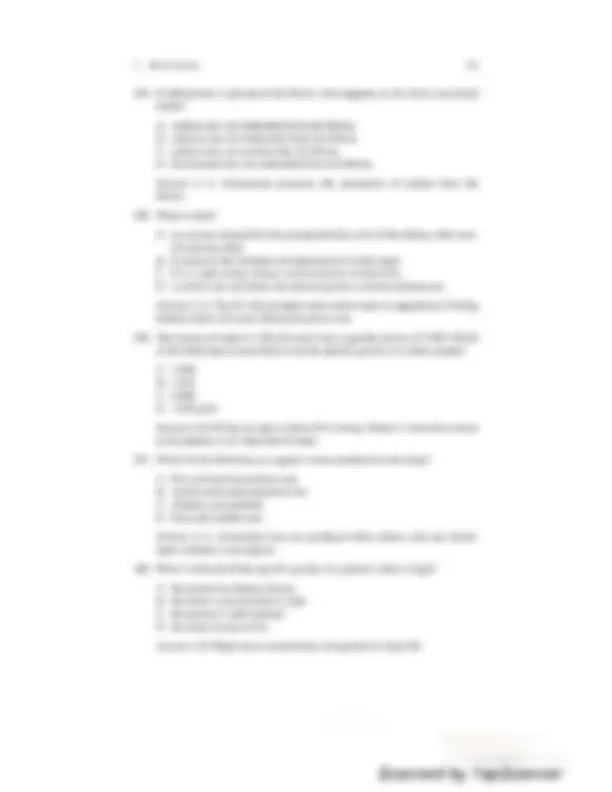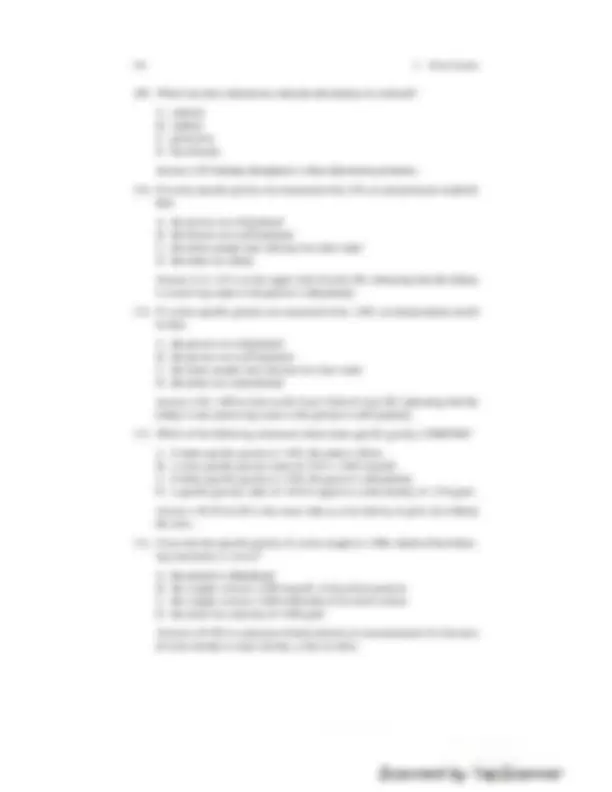Partial preview of the text
Download Anatomy and physiology Renal System question and answer notes and more Exams Animal Anatomy and Physiology in PDF only on Docsity!
11 Renal System . What is the name for the entry point to the kidney for nerves, blood vessels, ureters and lymphatics? A. calyx B. hilus C. pelvis D. pyramid Answer is B: Hilum is the name of the point of attachment between an organ and its supply services. . Where are all of the glomeruli of the kidney located? A. inthe medulla B. in the columns C. in the pyramids D. in the cortex Answer is D: The tubules and collecting ducts extend into the medulla, but all glomeruli are in the cortex. . What structure does the blood from the afferent arteriole enter? A. the peritubular capillaries B. the yasa recta C. the glomerulus D. Bowman’s capsule Answer is C: Afferent (incoming) arteriole enters the glomerulus, the efferent arteriole leaves the glomerulus. . Which part of the nephron is impermeable to water? A. Proximal convoluted tubule B. Distal convoluted tubule in the presence of ADH C. Ascending limb of the loop of Henle D. Descending limb of the loop of Henle Answer is C: The ascending limb. Hence volume of filtrate does not change as it passes through the ascending limb. Scanned by TapScanner 11 Renal System 213 5. Solutes move from the blood in the glomerular capillaries into the Bowman’s capsule due to which of the following influences? A. osmotic pressure difference B. diffusion down the concentration gradient C. by active transport D. hydrostatic pressure difference Answer is D: The efferent (outgoing) arteriole has a smaller diameter than the afferent arteriole, hence the glomerulus is a high pressure area. This aids the movement of dissolved substances through the filtration membrane. 6. Which material is actively reabsorbed from the filtrate in the kidney tubule? A. Nat B. HCO; e. cr D. H,0 Answer is A: All other substances are passively reabsorbed. 7. Which material is secreted into the filtrate in the kidney tubule? A. H,0 B. urea C. Na* D. albumin Answer is B: Urea (a waste product) is lipid soluble so can passively move out of the filtrate into the tubule cells. It is secreted back into the filtrate to effect its excretion. 8. Which of the following happens as we descend deeper into the kidney medulla? A. the concentration of the interstitial fluid doesn’t change B. the concentration of the interstitial fluid increases C. the concentration of the filtrate within the tubule increases D. the concentration of the interstitial fluid decreases Answer is B: Concentration of the interstitial fluid increases. Choice C is not correct as the nephron tubule does not necessarily descend into the medulla. 9. What molecule catalyses the formation of angiotensin I? A. carbonic anhydrase B. calcitriol C. erythropoietin D. renin Answer is D: Renin is an enzyme that catalyses the reaction that forms angio- tensin I from angiotensinogen. Scanned by TapScanner 11 Renal System 215 C. The juxtaglomerular apparatus releases renin which promotes diuresis D. The glomerular filtration rate increases so more urine is produced. Answer is B: ADH, from the posterior pituitary, would allow more water to be reclaimed from the filtrate so that plasma osmotic pressure does not increase further. Renin and its effects does not promote diuresis. 15. What is the kidney tubule’s response to a rise in blood pH? A. Bicarbonate ions are created from carbonic acid and absorbed into the blood. B. Hydronium ions are secreted into the filtrate, where they are buffered by bicarbonate ions in the filtrate. C. Bicarbonate ions are secreted into the filtrate, while hydronium ions are absorbed from the filtrate into the blood. D. Hydronium ions are secreted into the filtrate, while bicarbonate ions are absorbed from the filtrate into the blood. Answer is C: A rise in blood pH means it is getting more alkaline. That is there is too much bicarbonate in the blood. To counter this some bicarbonate ions are secreted into the filtrate, while some hydronium ions are absorbed from the filtrate into the tubule cells. 16. How does the composition of the filtrate change as it travels through the loop of Henle? A. In the ascending limb, the volume decreases and in the descending limb, the concentration increases. B. In the descending limb, the volume decreases and in the ascending limb, the concentration decreases. C. In the descending limb, the volume decreases and in the ascending limb, the concentration increases. D. In the ascending limb, the volume decreases and in the descending limb, the concentration decreases. Answer is B: The descending limb is permeable to water so water flows out of the tubule decreasing filtrate volume. The ascending limb is impermeable to water, so its volume does not change, however sodium, potassium and chlo- ride ions are reabsorbed which decreases the concentration of the filtrate. 17. What is the entry point to the kidney for the renal artery, renal vein, lymphat- ics and nerves called? A. renal pyramid B. renal hilus C. renal capsule D. renal column Answer is B: Hilus is a general term referring to the entry point (e.g. hilus of the lung) Scanned by TapScanner 216 11 Renal System 18. In what part of the kidney are the glomeruli located? A. In the cortex B. In the medulla C. In the hilus D. In the minor calyces Answer is A: Only the cortex contains glomeruli. 19. Four sections of the vasculature of the kidney tubule are listed below. Which one lists them in correct order of blood flow from left to right? A. efferent arteriole, glomerulus, afferent arteriole, peritubular capillaries. B. afferent arteriole, glomerulus, efferent arteriole, peritubular capillaries. C. peritubular capillaries, afferent arteriole, glomerulus, efferent arteriole. D. glomerulus, afferent arteriole, peritubular capillaries, efferent venule. Answer is B: The afferent arteriole carries blood into the glomerulus so must be first. 20. What method does the glomerulus of the kidney nephron use to remove the dissolved substances from the blood to the filtrate? A. active transport B. diffusion along the concentration gradient C. high hydrostatic pressure D. osmosis Answer is C: The larger diameter of the afferent arteriole along with the smaller diameter of the efferent arteriole creates a high pressure in the glom- erulus which facilitates filtration of dissolved material into the Bowman's capsule. 21. If the glomerular filtration rate is too high, the macula densa sends a message to the afferent arteriole. What is the effect of this message? A. granular cells of arteriole walls release renin B, afferent arteriole dilates C. it inhibits the action of ATP and adenosine on the afferent arteriole D. afferent arteriole constricts Answer is D: Constricting the afferent arteriole will decrease the rate of flow of blood into the glomerulus. This will decrease the GFR. 22. What is the effect of antidiuretic hormone on the kidney tubules? A. It causes Na’ to be absorbed from the filtrate into the tubular cells, B. It causes the concentration of urine to decrease. C. It causes the filtrate volume to increase. D. It causes the walls of the collecting duct to become permeable to water. Scanned by TapScanner 218 27. 28. 29. 30. a1. 11 Renal System Which list of structures is presented in the correct order in which urine passes through them on the way to the bladder? A. Ureter, minor calyx, major calyx, renal pelvis, papilla B. Renal pelvis, major calyx, minor calyx, papilla, ureter C. Papilla, minor calyx, major calyx, renal pelvis, ureter D. Minor calyx, major calyx, papilla, renal pelvis, ureter Answer is C: Collecting ducts empty into the papilla, so the papilla must be first. When systemic blood pressure increases, how does the kidney respond to maintain glomerular filtration rate? A. The afferent arteriole dilates B. The efferent arteriole constricts C. The efferent arteriole dilates D. The afferent arteriole constricts Answer is D: An increase in BP stretches the walls of the efferent arteriole which respond by constricting. The resulting decrease in diameter decreases glomerular blood flow which keeps GFR within normal limits. What may correctly be said of the juxtaglomerular apparatus (or complex)? A. The juxtaglomerular cells are chemoreceptors B. The granular cells are chemoreceptors C. The macula densa cells are chemoreceptors D. The macula densa cells are mechanoreceptors Answer is C: The macula densa cells are chemoreceptors that respond to changes in Na~ & CI ions. The granular cells are mechanoreceptors. What part of the nephron performs the majority of the reabsorption of materi- als from the filtrate? A. The Bowman’s capsule and glomerulus B. The loop of Henle (the nephron loop) C. The distal convoluted tubule and collecting duct D. The proximal convoluted tubule Answer is D: The proximal convoluted tubule (the first part or the renal tubule) absorbs most of the required material. Which of the following mechanisms operates in the nephron to maintain pH balance in the body? A. Bicarbonate ions from the tubule cells are secreted into the filtrate, then H* + HCO; > H,CO; > CO, + H,0 B. In tubule cells CO, + HO + H,CO,; + H* + HCO; then hydrogen ions are secreted into the filtrate Scanned by TapScanner 11 Renal System 219 C. In tubule cells CO, + H,O — H,CO, > H* + HCO, then hydrogen ions are transported into the peritubular capillaries D. In tubule cells CO, + HO + H,CO; - H* + HCO; then bicarbonate ions are secreted into the filtrate Answer is B: Carbon dioxide and water form hydronium and bicarbonate ions, the hydronium ions being secreted into the filtrate for excretion in urine. 32. What is the name of the tube that connects the bladder to the kidney? A. renal tubule B. ureter C. urethra D. collecting duct Answer is B: Not to be confused with the urethra through which urine exits the body. 33. Which of the following may be said of the renal medulla? A, itis the more superficial part of the kidney. B. it contains all of the glomeruli. C. it produces adrenaline and noradrenaline. D. it contains the pyramids and columns. Answer is D: The medulla is deep to the cortex. In this region are many blood vessel (in the columns) and the collecting ducts (in the pyramids) 34. What influences and structures facilitate blood filtration in the renal corpuscle? A. high osmotic pressure in the capillaries and sinusoidal capillaries B. high hydrostatic pressure in the capillaries and fenestrated capillaries C. high osmotic pressure in the capillaries and fenestrated capillaries D. high hydrostatic pressure in the capillaries and sinusoidal capillaries Answer is B: High hydrostatic pressure facilitates filtration and pores in the capillary walls (fenestre) allow easy passage. 35. In which part of the nephron does most of the reabsorption of water and sol- utes occur? A. the collecting duct B. the nephron loop (loop of Henle) C. the vasa recta D. the proximal convoluted tubule Answer is D: The PCT absorbs the bulk of the water and solutes. 36. Which statement about kidney anatomy is correct? A. The cortex is superficial to the medulla and contains all of the glomeruli. B. The cortex is deep to the medulla and contains the collecting tubules. Scanned by TapScanner 11 Renal System 221 40. What is the resulting effect of renin being released by the kidney? A. Angiotensin TT is formed B. aldosterone is released C. macula densa sends paracrine message to afferent arterioles. D. efferent arterioles are constricted Answer is A: Renin catalyses the formation of angiotensin T from angioten- sinogen, ACE then converts angiotensin I to angiotensin II. Aldosterone is released from the adrenal cortex due to angiotensin II. Angiotensin II also promotes systemic vasoconstriction (not just in efferent arteriole). 41. What is the effect on the kidney caused by increasing the release of ADH? A. the collecting duct becomes more permeable to water B. the ascending limb of the loop of Henle becomes impermeable to water C. the descending limb of the loop of Henle becomes permeable to water D. the collecting duct becomes impermeable to water. Answer is A: Antidiuretic hormone prevents diuresis (decreases urine forma- tion) by causing more water to be reabsorbed from the filtrate as it pi through the collecting duct. 42. The kidneys produce all of the following EXCEPT one. Which one? A. erythropoietin B. angiotensinogen C. hydronium ions D. bicarbonate ions Answer is B: Angiotensinogen is produced in the liver. Renin (produced in the kidneys) converts it to angiotensin I. 43. Which one of the following is part of the renal tubule? A. glomerulus B. vasa recta C. collecting duct D. macula densa Answer is D: The macula densa consists of cells in the wall of the distal con- voluted tubule at the juxtaglomerular apparatus. 44. From which part of the nephron is the greatest proportion of Na* absorbed from the filtrate? A. the Bowman's capsule (i.e. renal capsule) B. the proximal convoluted tubule C. the ascending limb of the loop of Henle D. the distal convoluted tubule Answer is B: The PCT absorbs about 65 % of the sodium from the filtrate. Scanned by TapScanner 222 Il Renal System 45. Complete the following sentence correctly. Angiotensin II A. stimulates the adrenal glands to release aldosterone B. increases potassium reabsorption from the filtrate C. increases sodium (Na’*) excretion at the kidneys. D. reduces our thirst Answer is A: Aldosterone is produced by the adrenal cortex in response to angiotensin II. A If also stimulates thirst. 46. What part of the renal tubule is NOT able to reabsorb water? A. the descending limb of the loop of Henle B. the proximal convoluted tubule C. the ascending limb of the loop of Henle D. the distal convoluted tubule Answer is C: The ascending limb is impermeable to water. 47. The influence (or influences) that drives blood filtration in the kidney is A. difference in osmolarity between blood in the glomerulus and filtrate in the Bowman’s capsule B. fluid pressure difference between blood in the glomerulus and filtrate in the Bowman’s capsule C. the osmotic pressure difference between blood in the glomerulus and fil- trate in the Bowman’s capsule D. diffusion along the concentration gradient between blood and filtrate, and active transport Answer is B: Filtration occurs because of a pressure difference. Osmotic pres- sure does not drive the process. 48. What does the renal system consists of? A. 2 kidneys, 2 urethra, bladder, | ureter. B. 2 adrenal glands, 2 kidneys, | ureter, 2 urethra, bladder. C. 2 adrenal glands, 2 kidneys, 2 ureters, 2 urethra, bladder. D. 2 kidneys, | urethra, bladder, 2 ureters. Answer is D: There are 2 ureters (from kidney to bladder) and one urethra (from bladder to outside). 49. Which of the statements about the capillaries of the glomerulus is NOT true? A. glomerular capillaries are fenestrated porous). B. blood enters and leaves the glomerulus via arterioles. C. the blood pressure in glomerular capillaries is higher (55 mmHg) than in the capillaries in the rest of the body. D. glomerular capillaries have smooth muscle in their walls. Answer is D: Capillary walls are made of endothelial cells, there is no smooth muscle. Scanned by TapScanner 224 Il Renal System 55. From which arteriole does blood enter the peritubular capillaries of the nephron? A. arcuate B. efferent C. afferent D. renal Answer is B: Efferent arteriole leaves the glomerulus and enters the peritubu- lar capillaries. 56. What is the term applied to the first process in urine formation, where some components of blood pass into the Bowman’s capsule? A. filtration B. active transport C. dialysis D. osmosis Answer is A: Filtration is the first process driven by a fluid pressure gradient. 57. To what does the “juxtaglomerular apparatus” refer? A. to those nephrons whose loop of Henle penetrate deep into the medulla B. to the lamina densa and podocytes that form filtration slits around the cap- illaries of the glomerulus C. to the capillaries that surround the loop of Henle of juxtamedullary nephrons D. to certain cells of the distal convoluted tubule where it touches the afferent arteriole, Answer is D: The juxtaglomerular = macula densa cells (of the DCT wall) and granular cells (of the afferent arteriole wall). $8. In what part (or parts) of the renal tubule reabsorb the least material from the filtrate? A. the distal convoluted tubule B. the loop of Henle C. the proximal convoluted tubule D. the distal convoluted tubule and the collecting duct together Answer is D: By the time the filtrate has passed through the PCT, loop of Henle the majority of the reabsorption that is going to happen has happened. Nevertheless, the DCT & collecting duct do reabsorb some electrolytes and water. Scanned by TapScanner 11 Renal System 225 59. By what name is the condition where nitrogenous wastes accumulate in the blood known? A. anuria B. uremia C. polyuria D. oliguriacv Answer is B: Uremia. The other terms describe the volume of urine produced. Anuria = no urine; polyuria = far more than normal; oliguria, less than normal. 60. Which statement about kidney anatomy is correct? Renal pyramids are in the: A. medulla and end in a papilla that empties into a minor calyx B. medulla and end in a column that empties into a major calyx C. cortex and end in a papilla that empties into a minor calyx D. cortex and end in a column that empties into a minor calyx Answer is A: Pyramids for the medulla. They contain collecting ducts that deliver urine a minor calyx via a papilla. 61. The kidneys produce all of the following except one. Which one? A. the enzyme renin B. the hormone erythropoietin C. antidiuretic hormone D. the vitamin calcitriol Answer is C: ADH is produced in the hypothalamus and released from the posterior pituitary. 62. In the nephron, if the afferent arteriole dilates and the efferent arteriole con- stricts, which of the following would be true? A. The glomerular filtration rate would decrease. B. The pressure in the glomerulus will decrease. C. The absorption of sodium and chloride ions form the filtrate would increase. D. Before these events, the granular cells would have released renin. Answer is D: The granular cells of the afferent arteriole respond to low blood pressure by releasing renin. As a result, angiotensin II would form which causes systemic vasoconstriction, which increases blood pressure, which dilates the afferent arteriole and increases glomerular filtration rate. 63. The majority of material reabsorbed from the filtrate is reabsorbed from the renal tubule: A. after the Loop of Henle B. in the descending limb of the Loop of Henle Scanned by TapScanner 11 Renal System 227 C. the distal convoluted tubule D. the collecting duct in the presence of aldosterone Answer is A: The PCT absorbs the greatest proportion of all things that are reabsorbed from the filtrate. It is the first part of the renal tube that filtrate passes through. 69. What is the purpose of ANP in urine production? A. stimulate the reabsorption of Na* B. stimulate the reabsorption of Ca** C. inhibit the reabsorption of Na* D. stimulate the reabsorption of water Answer is C: ANP triggers the dilation of the afferent arterioles and constric- tion of efferent arterioles which increases GFR. It also decreases sodium reab- sorption from the filtrate. Hence urine volume increases (and blood volume and pressure decreases). 70. What is the term used to describe the production of an insufficient volume of urine? A. polyuria B. uremia C, anuria D. oliguria Answer is D: Oliguria is the production of about 50-500 ml urine per day. Anuria is producing less than 50 ml per day. 71. By what process(es) do water and solutes move from blood in the glomerulus into the Bowman’s capsule? A. diffusion B. osmosis and diffusion C. filtration D. dialysis Answer is C: Filtration which is driven by the hydrostatic pressure difference between blood (at high pressure) in the glomerular capillaries and the filtrate (at lower pressure) in the Bowman’s capsule. 72. Complete the following sentence correctly. Antidiuretic hormone A. stimulates our thirst B. causes the wall of the collecting duct of the nephron to increase in perme- y to water. C. increases sodium (Na*) excretion at the kidneys. D. stimulates the adrenal glands to release aldosterone Scanned by TapScanner Ts 74, BBs 76. 11 Renal System Answer is B: Increased permeability of the collecting duct means that more water will be reclaimed from the filtrate. Angiotensin II stimulates thirst. ANP diminishes thirst and increases sodium secretion at the kidneys. Complete the following sentence correctly. Angiotensin IT A. stimulates the adrenal glands to release aldosterone B. causes the wall of the collecting duct of the nephron to increase in perme- ability to water C. increases sodium (Na*) excretion at the kidneys. D. reduces our thirst Answer is A: ADH increases the permeability of the collecting duct to water. ANP diminishes thirst and increases sodium secretion at the kidneys. Complete the following sentence correctly. Atrial natriuretic peptide A. causes the wall of the collecting duct of the nephron to increase in perme- ability to water B. increases sodium (Na’*) excretion at the kidneys. C. causes peripheral vasoconstriction D. stimulates the adrenal glands to release aldosterone Answer is B: ADH increases the permeability of the collecting duct to water. Angiotensin II stimulates the adrenal glands to release aldosterone and pro- motes peripheral vasoconstriction. What is the place where the arteries, veins, lymphatics and nerves enter or leave the kidney called? A. The carina B. The reno-atrio notch C. The renal pelvis D. The hilus Answer is D: Carina is in the trachea; renal pelvis refers to the ureter; reno- atrio notch does not exist. The nephrons of the kidney consist of . Bowman’s capsule, a loop of Henle, a collecting duct and a renal tubule . a juxtaglomerular apparatus and collecting duct . a glomerulus and a juxtaglomerular apparatus . a glomerulus, a proximal convoluted tubule, loop of Henle, and a distal convoluted tubule cam> Answer is D: The nephron includes the glomerulus and renal tubule. The later includes the Bowman’s capsule. Choice D is best even though Bowman’s cap- sule is not listed. Scanned by TapScanner 230 11 Renal System C. production of less than 50 ml of urine in a day D. the condition of excessive concentration of urea in the blood Answer is B: Oliguria refers to a less than normal daily volume of urine being produced. Normal is about two litres per day. 82. Glomerular filtration rate can be altered by all of the following EXCEPT one. Which one? A. constriction of renal tubule by macula densa B. vasoconstriction of afferent arteriole C. decrease in concentration of plasma proteins D. vasoconstriction of efferent arteriole Answer is A: Macula densa does not constrict the tubule. A decrease in plasma protein would increase the osmotic pressure opposing glomerular filtration. 83. Filtrate passes through each of the structures of the renal tubule listed below. Which list has the structures in the correct order? A, proximal convoluted tubule, descending limb, ascending limb, distal con- voluted tubule, collecting duct. B. Bowman’s capsule, proximal convoluted tubule, ascending limb, distal convoluted tubule, descending limb. C. collecting duct, proximal convoluted tubule, descending limb, ascending limb, distal convoluted tubule. D. proximal convoluted tubule, distal convoluted tubule, descending limb, ascending limb, collecting duct. Answer is A: The descending and ascending limbs should be between the PCT and DCT, while the collecting duct is last. 84. What is the role of aldosterone? A. to convert angiotensinogen into angiotensin I. B. to inhibit the absorption of Na’. C. to promote the absorption of Na*. D. to promote the absorption of Ca**. Answer is C: Sodium ions are always reabsorbed from the filtrate, Aldosterone promotes greater reclamation of sodium from the DCT. 85. Which one of the statements about the collecting ducts is true? The collecting duct absorbs: . calcium if parathyroid hormone is present. . water if antidiuretic hormone is present. . sodium if atrial natriuretic hormone is NOT present. urea. vow> Scanned by TapScanner 11 Renal System 231 Answer is B: ADH cause aquaporins (water channels) to be inserted into the collecting duct walls. The collecting duct is impermeable to the other substances. 86. One way to increase the glomerular filtration rate is to dilate: . the afferent arteriole and to constrict the efferent arteriole. . the efferent arteriole and to constrict the afferent arteriole. . both the afferent arteriole and the efferent arteriole. . the efferent arteriole and to increase the permeability of the capillary endothelium. GaAMP> Answer is A: Dilating the afferent arteriole increases the volume of blood flowing into the glomerulus, while constricting the efferent arteriole decreases the volume of blood leaving the glomerulus. This means water and solutes must leave the glomerulus and enter the Bowman’s capsule, that is GFR increases. 87. The nephron of the kidney consists of which of the following structures? A. glomerulus, renal tubule and collecting duct. B. bowman’s capsule, proximal convoluted tubule, loop of Henle, and distal convoluted tubule. C. glomerulus and renal tubule D. renal tubule and collecting duct. Answer is C: The glomerulus and renal tubule together constitute the nephron. 88. What name is given to the blood vessel that drains blood from the glomerulus after filtration? A. vasa recta B. afferent arteriole C. efferent arteriole D. efferent vein Answer is C: Efferent means outgoing. 89. Through which structure must the filtrate move to enter the Bowman’s capsule from the glomerulus? . The capillary endothelial cell walls . The capillary endothelial wall and basement membrane . The capillary endothelial wall, basement membrane and podocytes . The capillary endothelial wall, basement membrane, podocytes and the vasa recta Dam, Answer is C: Together these three structures form the filtration membrane Scanned by TapScanner 
